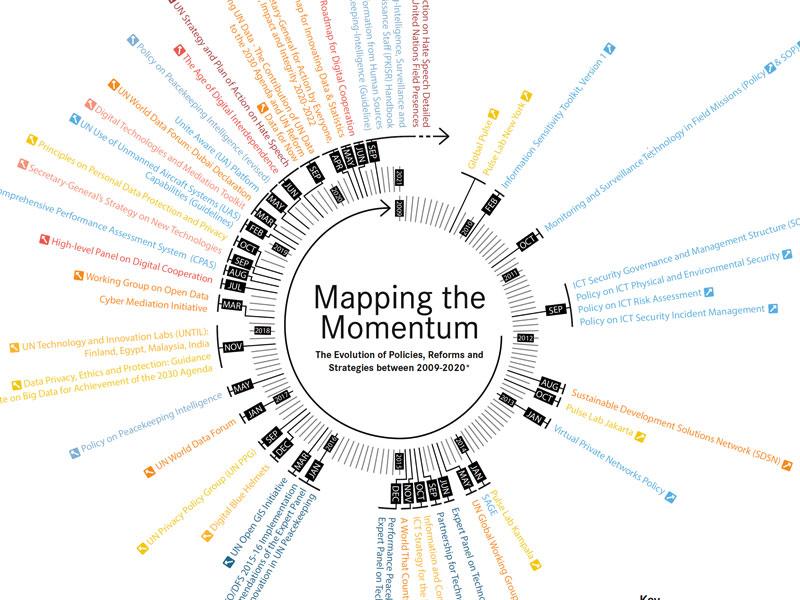The forest and the trees: Mapping UN digital technology initiatives
Exploring the impact of digital technology on conflict dynamics and peace operations | Irina SiminichinaDigital technology is a hot topic in many organizations, regardless of whether they are private companies, Non-Governmental Organizations (NGOs), or international organizations. The United Nations, including UN peacekeeping, is no exception. The 2000 Brahimi report already emphasized the importance of "adapting peace operations to the information age" (S/2000/809), stressing the potential and opportunities inherent in using technologies to improve peacekeeping operations. Over the years, other resolutions and initiatives followed suit. In an effort to understand the forest as well as the trees, ZIF mapped relevant Security Council and General Assembly resolutions as well as major UN strategies, reform initiatives, and policies launched in the past ten years on the topic of (digital) technologies – for the UN as a whole and peacekeeping in particular. The result of this endeavor is shown in the visualization “Mapping the momentum - the UN, digital technologies and peacekeeping”, which demonstrates two main insights: First, since 2014, the UN system as a whole and UN peacekeeping have thoroughly recognized the risks and potential of technologies. Second, while the UN generally started to deal increasingly with the impact of data and digital technologies, peacekeeping lags behind on these subjects.
The UN's call for data and the push for privacy
In particular, the kick-off of Global Pulse (initially known as the Global Impact and Vulnerability Alert System) in 2009 brought big data and how to harness its advantages onto the UN agenda - even if the General Assembly had earlier also dealt with the role of ICTs for development (see A/RES/62/182 in 2007 and A/RES/ 63/202 in 2008) or the threats emanating from ICT (A/RES/62/17 in 2007 and A/RES/63/37 in 2008). Global Pulse is ongoing and continues to deliver multiple outputs – most notably the Pulse Labs in New York (2009), Jakarta (2012), and Kampala (2014), which primarily produce scientific articles and develop specific applications. An example is a data-driven evaluation of public health interventions in Cox's Bazar during Covid-19. Moreover, Global Pulse is a strong policy advocate and chairs further initiatives like the UN Privacy Policy Group (UN PPG) established in 2016. UN PPG itself developed guidelines like the Data Privacy, Ethics and Protection: Guidance Note on Big Data for Achievement of the 2030 Agenda in 2017 and the Principles on Personal Data Protection and Privacy in 2018. In doing so, the UN emphasized the need for data gathering to be accompanied by data protection.
Download full infographic
© ZIF, design: infotext-berlin.de
The UN's renewed focus on data and digital cooperation
Although after the launch of Global Pulse, the UN GA kept passing the previously mentioned yearly resolutions on ICTs or cybersecurity (A/RES/64/211 in 2010), trendsetting initiatives only started to accelerate in 2014. The establishment of the UN Global Working Group (GWG) on Big Data for Official Statistics is a clear example of a step towards a "strategic vision, direction, and coordination of a global program on Big Data [...]". Furthermore, the inclusion of goal 9c in the Sustainable Development Goals (SDGs), i.e., to increase ICT access bearing in mind the digital divide among countries worldwide, indicated the UN's desire to retain digitalization as a priority on its agenda. This prioritization culminated in two landmark actions in the past five years; the High-level Panel on Digital Cooperation in 2018 and the Data Strategy of the Secretary-General for Action by Everyone, Everywhere with Insight, Impact and Integrity in 2020.
Both long-term initiatives aim to deal with digital technologies' transformative impact; the potential harm weighed against the benefits, especially in achieving the SDGs. Both also followed up with the release of roadmaps in 2020 with the intent to outline more operational and actionable tasks: The Secretary General's Roadmap for Digital Cooperation and the System-wide Roadmap for Innovating Data & Statistics. The latter proposes a coherent and contemporary approach to data and statistics at the UN System, thus in line with the Data Strategy, as well as national ones. The former also considers current problems, particularly how digital technologies can help address the Covid-19 pandemic, next to known issues like digital inclusion, digital threats such as cyberattacks, the spread of misinformation on social media, and human rights (protection against surveillance). One of the differences between the two strategies is the target audience. While the Data Strategy aims to improve the UN's internal functioning, the High-Level Panel wants to strengthen the cooperation between different stakeholders beyond international organizations, i.e., governments, civil society, private sector (tech companies), and academia. In line with the Panel's goal, the GA also pledged to improve digital cooperation in its resolution commemorating the United Nations' seventy-fifth anniversary (A/RES/75/1).
UN Peacekeeping – "Behind the curve" of the digital age
Within the same resolution, the GA also made a statement on peace and conflict and called upon the SG to "enhance [the diplomatic toolbox of the Charter] to prevent the outbreak, escalation and recurrence of hostilities on land, at sea, in space and in cyberspace". Without neglecting the importance of diplomacy, the question is, though, what such a toolbox might look like when it comes to technologies. As seen above, even if not a panacea, the UN does see technologies as a vehicle to achieve the SDGs, not least SDG 16 on peace, justice and strong institutions, which aims to promote peaceful societies. Equally, the Data Strategy sets peace and security as one of the priorities and asks, for example, how data usage can accelerate the appropriate deployment of missions and account for impact.
It is safe to say that the improvement of peacekeeping was continuously on the UN agenda. For instance, the report A new partnership agenda – Charting a new horizon for UN peacekeeping (2009) addresses the challenges missions face and sets goals to meet them. Likewise, did the 2015 report of the High-level Independent Panel on Peace Operations (HIPPO) provide recommendations for the challenges missions face (A/70/95–S/2015/446), while the Secretary-General's subsequent report on the implementation of these recommendations (S/2015/682) pointed to the significance of information technology, data, and analysis for peacekeeping. Nevertheless, while peacekeeping's operational effectiveness was of importance, the issue of technology remained implicit in these major initiatives. From 2010 until 2014, the focus on technology was primarily visible in internal policies and guidebooks that dealt with technologies' use and implications. In June 2014, the same year as the HIPPO panel, a broader strategic focus was set out with the Expert Panel on Technology and Innovation in UN Peacekeeping. The Panel's deliberations and suggestions converged in December 2014 in the well-known final report on Performance Peacekeeping, where gaps and strengths were identified, and was followed by an 18-month implementation strategy in January 2016. However, peacekeeping’s engagement with technology seemed to have lost its strategic momentum after the 2014 report – at least when compared explicitly to the scale of the initiatives launched at the UN-system level.
Synergies and the missions' opportunity to learn from the wider UN system
In the following years, an engagement with digital technologies in peacekeeping took place in some areas. Attention continued to be directed at peacekeeping intelligence, with a first policy issued in 2017 and data gathering capabilities improved with SAGE, Comprehensive Performance Assessment System (CPAS), and the Unite Aware platform. In addition, individual initiatives within missions to enhance their technological capabilities were also under constant review. However, in 2020 digital technologies and the impacts of data on peacekeeping missions are awaiting a comprehensive reassessment and future perspectives. On the bright side, the 2018 Action for Peacekeeping (A4P) initiative represents a political push and renewed commitment to address several outstanding issues in peace operations and can provide a framework through which to pursue the use of digital technologies more strategically. Moreover, the wider UN data and digital strategies equally offer a solid framework upon which missions can build. For example, the UN's actions on data privacy and protection can serve as a reference point for protecting data, which tend to be particularly sensitive in a conflict environment.
From strategies to action
The mapping and the resulting visualization in “Mapping the momentum - the UN, digital technologies and peacekeeping” show that digital technologies are a continuing agenda point for the UN. Aside from the system-wide and peacekeeping-specific initiatives, UN Agencies, Funds and Programmes (AFPs) also launched policies and guidelines to address this topic. For example, UN's International Telecommunication Union (ITU) launched ITU's Partnership on Measuring ICT for Development: Information and communication technology statistics. The United Nations Development Programme (UNDP), a close partner of peacekeeping, also developed its own digital strategy Future Forward 2019-2021. While we did not consider these in the visualization, the UN's evolution is apparent: from having single resolutions emphasizing data and ICTs here and there to developing broader strategic foresight on how to profit from digital technologies, especially data, without ignoring the drawbacks. How these developments within the wider UN system will be applied for peacekeeping remains to be seen.
What is essential for both the UN in general and peacekeeping, in particular, is not to let their strategies fade out and become well-intended but unimplemented programs. To avoid this, peacekeeping could learn from other UN agencies, like UNDP, which rolled out several applications to promote and track peace (Crisis and Recovery Mapping and Analysis project in 2009 or PeaceApp in 2014 together with UNAOC), and collaborated on multiple projects with other agencies. An example of the latter is the UWIANO Platform for Peace in Kenya (2010), a conflict prevention strategy to foster collaboration between peace actors to reduce electoral violence. The mapping also does not include the multitude of NGO and civil society initiatives that offer lessons and insights for peacekeeping (see, for example, the Data for Peacebuilding and Prevention Ecosystem Mapping: The State of Play and the Path to Creating a Community of Practice). These organizations often develop tangible digital methods, tools, and applications to monitor, influence, and document a conflict situation, especially in the area of peacebuilding. According to the Build Peace Database, since 2013, there have been 168 projects to promote peace with technological components. Working with agencies outside of the UN domain is in line with the UN goal to foster digital cooperation amongst different stakeholders. It also provides a pool of knowledge and examples of how one could transition from strategies to definable actions that can serve peacekeeping well.
Download article
IMAGES
- Author | David Außerhofer, Stiftung Mercator
- Infographic | © ZIF, design: infotext-berlin.de

